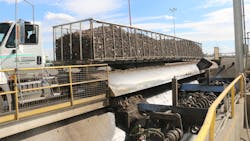In Wahpeton, North Dakota, at the southern end of the Red River Valley, sits 100,000 acres of sugar beet farms - MINN-DAK Farmers Cooperative. The sugars from the plants are extracted and purified into sugar before being shipped to grocery stores and food manufacturers.
A change in equipment
During harvest, sugar beet plants are defoliated and cleaned off. Then they are piled up at receiving stations, waiting to be transported to the factory by an International or Freightliner truck hauling an East MMX Flatbed Trailer. East Manufacturing Corp. is a manufacturer of aluminum platform, dump and refuse trailers and steel dump trailers and dump bodies.
MINN-DAK previously used a smaller 45’ trailer with a regular hauling capacity of 80,000 lbs. Then, the state of Minnesota passed the agriculture commodities permit.
“The state of Minnesota came out with a new permit that increased our gross weight from 80,000 to 97,000 [pounds],” says Darrell Oscarson, transportation supervisor at MINN-DAK. “It gave us a good opportunity to rethink our equipment needs and to take advantage of the [new] law.”
For its new trailer, MINN-DAK chose the 53’ East MMX with the help of Joel Hought, a dealer at Wallwork Truck Center. Now totaling 19, the flatbed trailers are equipped with a metal cage to contain the sugar beets when they’re hauled from the stockpiles to the factory. The stockpiles are kept cool with tubes that distribute air throughout the piles.
A driver can typically haul seven loads per 12-hour shift when he or she is hauling from the farthest out stockpiles, which are up to 30 miles away. The typical number of loads increases up to 13 loads per 12-hour shift when hauling from the closer piles. To carry these heavy loads, East worked closely to add control valves to operate its fully automatic lift on the fourth axle.
Once to the sugar factory, each trailer is driven onto the wet hopper. It is then tilted to the side to dump the sugar beets, a process that was causing problems with the co-op’s previous trailers.
“What was happening on the older trailers was, where the axles were attaching to [the trailer], the brackets weren’t strong enough, so they were cracking and we were seeing some issues,” he says. “They were using straps to keep the axles from stretching and, of course, the straps would break. More maintenance, more time ... downtime is money.”
To prevent this from happening with the new trailers, Oscarson spec’d them with extra gussets over the axles. Because the tilting process puts pressure on the axle sides, the gussets run from the deck to the frame to provide more rigidity to the trailer to alleviate side pressure.
Oscarson says East workmanship is of the highest quality he has found. He notes that while seven years is the industry standard for the life of a trailer, “this is year nine [using the East trailers], we’re going on year 10 now, and I really don’t know where the end is going to be; I hope it’s 10 more.”
When the trailer being dumped reaches a 12 degree angle, the mercury switch in an enclosed box engages and allows the side to open, releasing the beets. Since trailers are exposed to temperatures down to -30 degrees F, Mercury switches were chosen for the controls. “They’ve got to be responsive with temperature extremes, too. One day it may be -30 degrees and the next it may be up to 40 degrees,” Oscarson says.
The automatic switch saves two or three minutes per truckload, with MINN-DAK averaging 420 tons per hour, or up to 340 loads per day. The process is repeated over and over, 24-hours a day, seven days a week, up to nine months out of the year.
Maintaining the fleet
MINN-DAK focuses on all details to keep their operation moving forward daily. Before the trailers go out each day, they are inspected like aircraft. Inspections go through every bushing and component, using a checklist to make sure that nothing is missed.
Any item on the checklist that is marked with an asterisk is considered a mandatory inspection item, Oscarson notes, since they are part of the annual federal inspection to certify the trailers. The inspection requirements include items such as:
- Overall trailer condition
- Parking brakes
- Lights and wiring
- Gladhands and seven-way plug
- ICC bumper
- Kingpin
- Frame and subframe
- Cross members and gussets
- Spring hanger/wear pads/air suspension
- Equalizers and bushings
- Radius rods and bushings
- Alignment between axles
- Spring u-bolts, saddles and seats
The list also includes a full brake system inspection (with adjustment and service as necessary), a wheel and tire inspection and more. Keep in mind, these are just some of the required items. MINN-DAK also includes non-mandatory items on the checklist, such as washing the trailer, checking ID plates and registration holders and inspecting dump and flatbed components. The inspection sheet also includes a diagram of the wheels and axles so that technicians can easily record the tread depth and axle alignments.
While the trailers originally came with incandescent lights, MINN-DAK has converted them all to LED, and any new trailers are spec’d with LEDs from the factory, Oscarson confirms. This is due to the fact that LEDs draw less power and last significantly longer than incandescent bulbs, reducing the frequency for maintenance.
Oscarson notes another change that the co-op has made, switching the rear bearings from gear lube to Chevron Delo Synthetic Grease SF.
“The rear bearings used to be fluid: 80W-90 gear lube," he says. "We found that doing a wheel seal takes time, so we got with a local oil engineer and said, ‘Is there a chance we could use a semi-synthetic grease?’ And he said, ‘I’ve got something even better for you.’”
Making this change has allowed MINN-DAK to reduce the amount of maintenance required on the fourth axle.
“We put a new seal on it, we pack [the grease] in there and we put a different style cap on it to allow moisture to stay out, but let it breathe as well,” Oscarson says. “By doing that, we’ve eliminated changing wheel seals on that fourth axle all season now, so that saves us probably 20 wheel seals a year.”
Completing the process
After the trailer empties its load into the wet hopper, the beets fall into the flume where water takes them into the washhouse. Stones, topsoil and other foreign materials are removed. After being washed, they’re sliced into thin strips called cossettes. The cossettes are tested for weight and sampled for sugar content and other criteria. The sugar content of sugar beets varies from field to field, so sugar beet samples are weighed and tested.
After slicing the beets, the raw juice is extracted from the cossettes. The raw juice is then mingled with milk of lime and carbon dioxide gas produced from the limekiln in carbonation tanks. The carbon dioxide bubbles through the mixture, reacting with the milk of lime to form a calcium carbonate. The non-sugar particles attach themselves to the calcium carbonate and settle to the bottom of the tanks, leaving a clear juice. This juice is boiled in evaporators, forming a thicker juice with the consistency of pancake syrup. After a second filtration to ensure that all non-sugar materials have been removed, the juice is boiled under vacuum and crystals begin to form.
The resulting sugar crystal and syrup mix is called massecuite. The massecuite is then separated by spinning rapidly in a perforated cylindrical basket. The syrup is thrown off and passes through the screen holes. Clean hot water is used to wash the sugar, producing pure white sugar crystals. The damp white sugar crystals are dried, cooled, separated into various sizes of sugar crystals and then stored in a temperature and humidity controlled environment.
MINN-DAK produces up to 3,500,000 lbs of all-natural sugar every day, which is over 2,000 lbs of sugar per minute. The process is completed when sugar is shipped to MINN-DAK’s food manufacturer customers in bulk or packaged form throughout North America.

